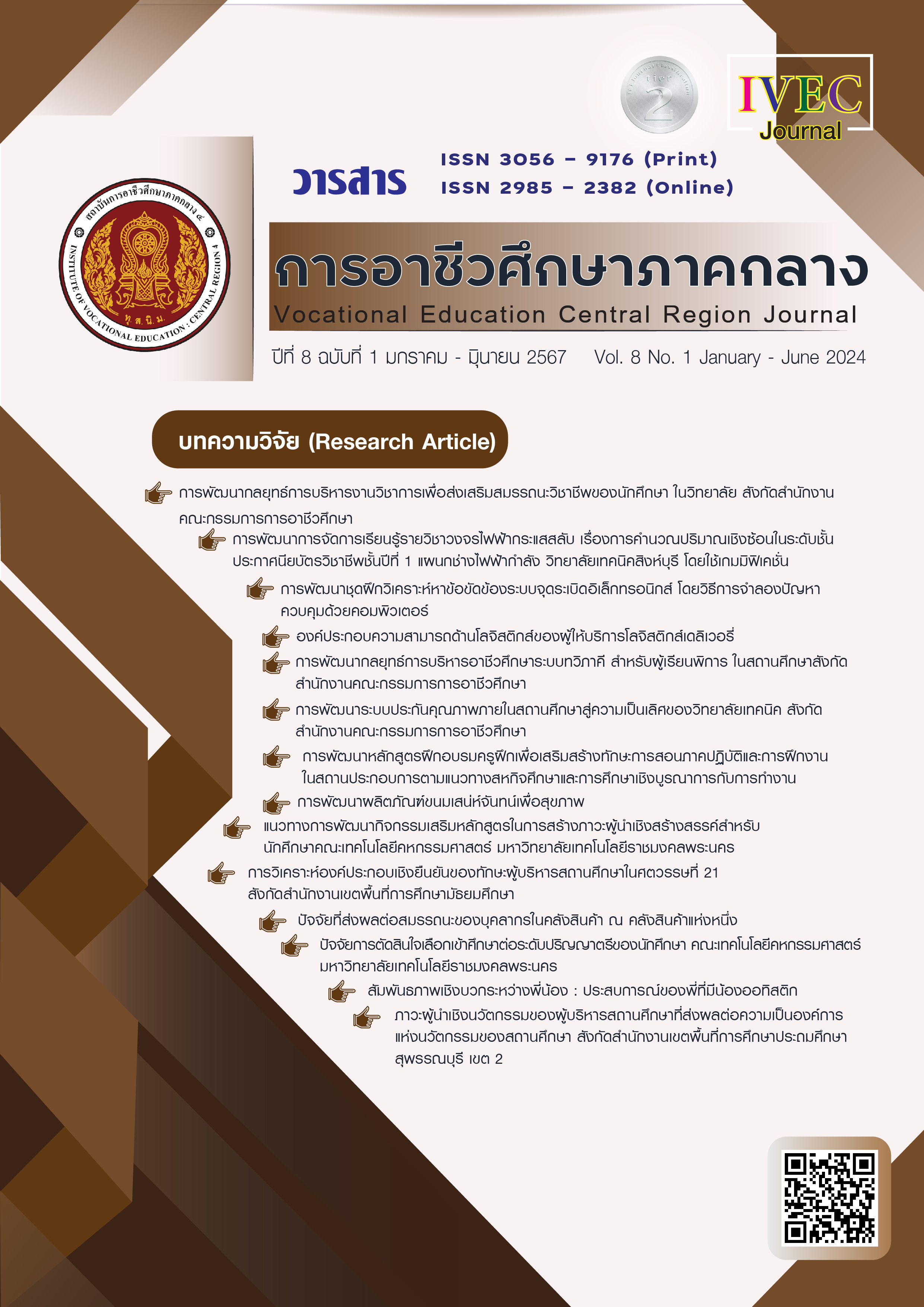The Development of Kanom Saneh Chan Product for Health
Main Article Content
Abstract
The objective of this research wears to 1) study the basic recipe of Kanom Saneh Chan. 2) Study the effect of using stevia as a substitute for granulated sugar and cereal cream in the Saneh Chan recipe. and 3) study the nutritional value of Saneh Chan desserts that use stevia sugar instead of partial granulated sugar and cereal cream instead of coconut milk. By evaluating the quality of the sensory test in terms of appearance using the 9-Point Hedonic scale. Research results with experimental planning and static analysis was found that 1) The basic recipe of Saneh Chan that was selected contained 110 grams of rice flour, 15 grams of glutinous rice flour, 250 grams of coconut milk, 185 grams of granulated sugar, 420 grams of egg yolk, 0.5 grams of ground nutmeg powder, and yellow and brown food coloring. 2) The developed recipe uses stevia sugar instead of 50% granulated sugar and cereal cream instead of 100% coconut milk. 3) The nutritional value of Khanom Saneh Chan, which uses 50% stevia sugar and 100 cereal cream, has nutritional values like the basic recipe. Which has an energy value of 359.66 kcal, 7.29 grams of protein, 16.38 grams of fat, 29.66 grams of moisture, 45.77 grams of carbohydrates, and 11.09 grams of sugar.
Article Details

This work is licensed under a Creative Commons Attribution-NonCommercial-NoDerivatives 4.0 International License.
|
บทความ ข้อมูล เนื้อหา รูปภาพ ฯลฯ ที่ได้รับการตีพิมพ์ในวารสาร การอาชีวศึกษาภาคกลาง ถือเป็นลิขสิทธิ์ของวารสารการอาชีวศึกษาภาคกลางหากบุคคลหรือหน่วยงานใดต้องการนำทั้งหมดหรือส่วนใดส่วนหนึ่ง ไปเผยแพร่ต่อหรือเพื่อกระทำการใด ๆ กองบรรณาธิการไม่สงวนสิทธิ์ ในการคัดลอกบทความเพื่อการศึกษาแต่ให้อ้างอิงแหล่งที่มาให้ครบถ้วน สมบูรณ์ สงวนสิทธิ์ โดย สถาบันการอาชีวศึกษาภาคกลาง 4 ที่ตั้ง 90 ถนนเทศา ตำบลพระปฐมเจดีย์ อำเภอเมือง จังหวัดนครปฐม โทรศัพท์ 034 242 856 , โทรสาร 034 242 858 ISSN : 3056-9176 (print) ISSN : 2985-2382 (online) |
References
กองโภชนาการ กรมอนามัย กระทรวงสาธารณสุข. (2544). ตารางแสดงคุณค่าทางโภชนาการของอาหารไทย (Nutritive values of thai foods).นนทบุรี: โรงพิมพ์องค์การสงเคราะห์ทหารผ่านศึก.
จริยา เดชกุญชร. (2549). ขนมไทย เล่ม 2. กรุงเทพฯ: เพชรการเรือน.
นิดดา หงษ์วิวัฒน์. (2557). ขนมไทย. กรุงเทพฯ: แสงแดด.
ปพนวีณ์ สุทธิประสิทธิ์. (2560). การทดสอบและการประเมินคุณภาพอาหารด้วยวิธีการทางประสาทสัมผัส. กรุงเทพฯ: มหาวิทยาลัยสุโขทัยธรรมาธิราช.
พิมพ์เพ็ญ พรเฉลิมพงศ์ และ นิธิยา รัตนาปนนท์. (ม.ป.พ.). คุณภาพอาหาร. ค้นเมื่อ ตุลาคม 15, 2563, จาก http://www.foodnetworksolution.com/wiki/word/3022
รุ่งทิวา วงค์ไพศาลฤทธิ์. (2553). ขนมไทยในงานพิธี. กรุงเทพฯ: ไทยควอลิตี้บุ๊คส์ (2006).
วรารัตน์ สานนท์. (2552). การพัฒนาขนมหม้อแกงไข่ลดพลังงานและการปรับปรุงสัดส่วนกรดไขมันด้วยสารให้ความหวานซูคราโลสและกะทิธัญพืช. วิทยานิพนธ์ ปริญญาวิทยาศาสตรมหาบัณฑิต สาขาวิชาคหกรรมศาสตร์ มหาวิทยาลัยเกษตรศาสตร์.
วิชชุดา สังข์แก้ว และ สุกฤษฎ์ ประดิษฐวัฒนะกุล. (2557). การพัฒนาผลิตภัณฑ์ไอศกรีมลดพลังงานโดยใช้สารสกัดจากหญ้าหวานทดแทนน้ำตาล. วิทยาศาสตร์เกษตร, 45, (2), (พิเศษ), หน้า 717-720.
วันทนีย์ เกรียงสินยศ. (2551). การพัฒนาผลิตภัณฑ์อาหารเพื่อป้องกันและการจัดการโรคอ้วนและโรคไม่ติดต่อเรื้อรัง. ในการประชุมวิชาการโภชนาการแห่งชาติ ครั้งที่ 3. (1-3 ตุลาคม หน้า 64-68). นนทบุรี: สมาคมโภชนาการแห่งประเทศไทย.
เศรษฐสิริ วัจนพรพิศาล, ปิยะเมธ ทองเมธา, ลินจง สุวรรณรัตน์ และ ทัศนันท์ จวงสาง. (2558). เอกสารประกอบการฝึกอบรมหลักสูตรขนมไทยโบราณสร้างสรรค์สู่ครัวโลก. ฉะเชิงเทรา: วิทยาลัยอาชีวศึกษาฉะเชิงเทรา.
สิริมนต์ ชายเกตุ, พรเพ็ญ มรกตจินดา, และ วีณา ทองรอด. (2560). การพัฒนาขนมไทยเพื่อสุขภาพ: กรณีศึกษาขนมทองเอก. หน่วยวิจัยวิทยาศาสตร์เทคโนโลยีและสิ่งแวดล้อมเพื่อการเรียนรู้, 8, (2), หน้า 261-269.
สุปราณี แพรศิริ. (2537). ขนมไทย. กรุงเทพฯ: เอ็มไอเอส.
อบเชย วงศ์ทอง และ ขนิษฐา พูนผลกุล. (2559). หลักการประกอบอาหาร (พิมพ์ครั้งที่ 13). กรุงเทพฯ: มหาวิทยาลัยเกษตรศาสตร์.
อภิชชญา มัยตรีเดช, ปานจิต ป้อมอาสา, วิสันต์ บุญสาร และ สิริมา เถกิงวงศ์ตระกูล. (2563, มกราคม–เมษายน). การพัฒนาผลิตภัณฑ์วุ้นกรอบสตรอเบอร์รีลดพลังงานด้วยหญ้าหวาน. วิทยาศาสตร์บูรพา. 25, (1), หน้า 141-149.
อลงกต สิงห์โต, อุไรภรณ์ บูรณสุขสกุล, รังสิมา ดรุณพันธ์, และ นริศา เรืองศรี. (2563, กรกฎาคม-ธันวาคม). การยอมรับและความพึงพอใจต่อตำรับขนมไทยสูตรลดไขมัน. บูรพาเวชสาร , 6, (2), หน้า 17-27.
Savita, S. M., Sheela, K., Sunanda, S., Shankar A. G., & Ramakrishna, P. (2004). Stevia rebaudiana-A Functional Component for Food Industry. Journal of Humans Ecology, 15, (4), pp. 261-264.


